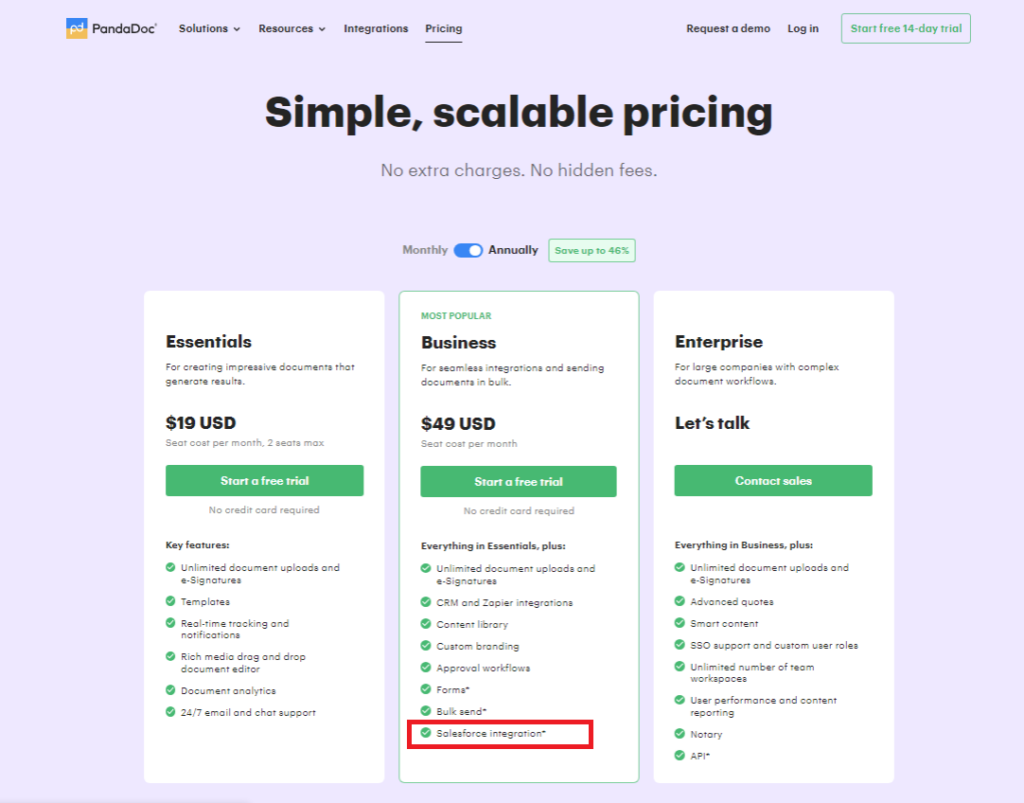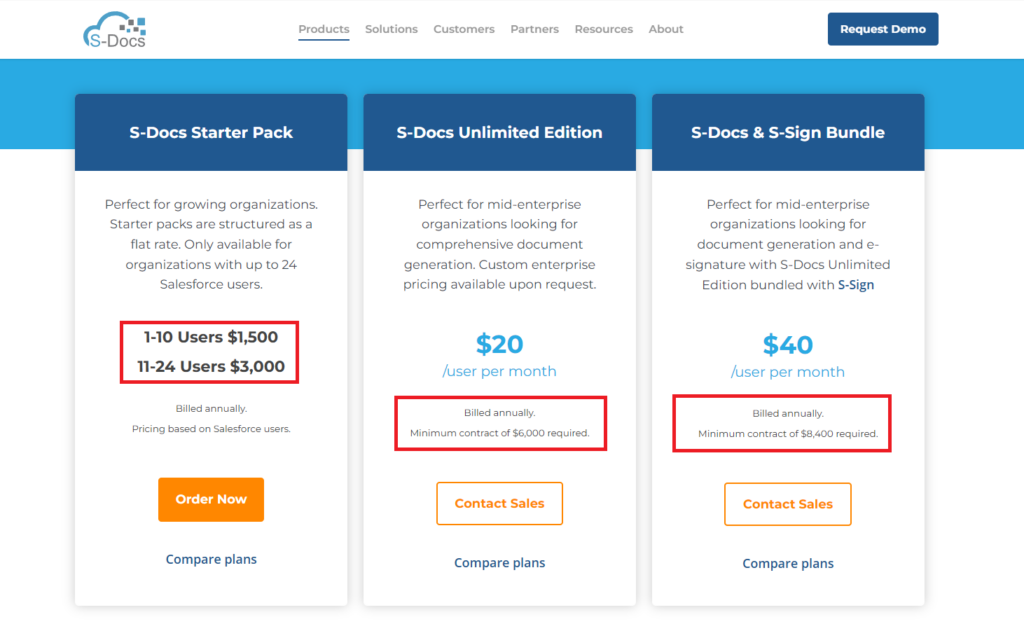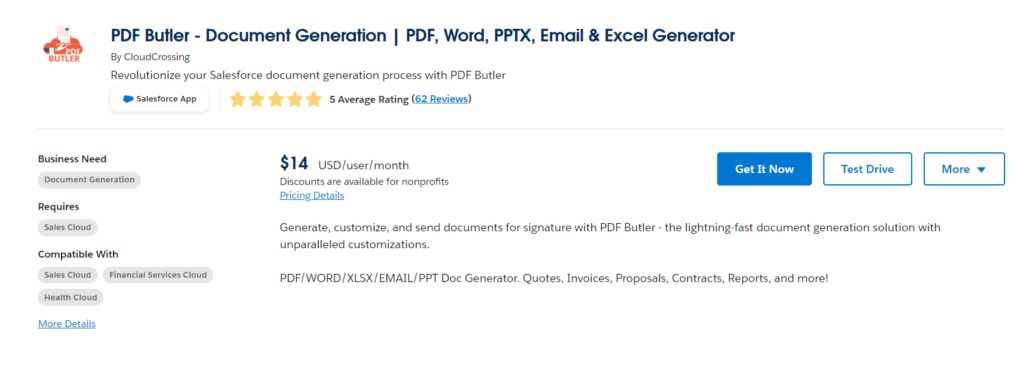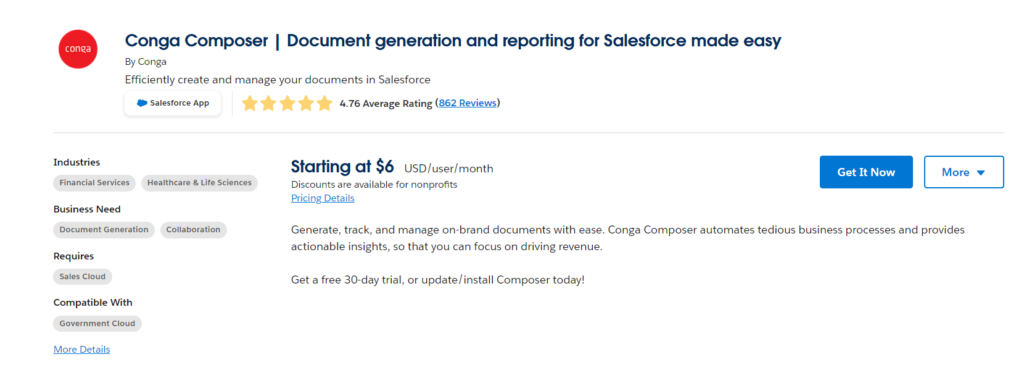Salesforce Document Generation
Introduction
Document generation, the automated process of creating digital and printable materials from templates and data sources, has become a foundational element in today’s digital business ecosystem. As organizations increasingly shift towards data-driven operations, the ability to swiftly generate accurate, personalized, and relevant documents becomes not just an asset but a necessity.
The Importance of Document Generation
In the fast-paced world of modern business, speed and accuracy are paramount. This is especially true for document creation. Whether it’s producing customer invoices, generating detailed reports, or crafting contractual agreements, the ability to do so efficiently can significantly impact a business’s productivity, customer satisfaction, and overall bottom line.
Automated document generation:
- Reduces Human Error: Automation minimizes the risk of mistakes that can happen during manual data entry or when transferring data between platforms.
- Enhances Productivity: Instead of spending hours creating individual documents, staff can focus on other vital tasks, thereby increasing operational efficiency.
- Ensures Consistency: Every document produced will maintain a consistent format and style, ensuring a professional appearance and brand alignment.
- Allows for Personalization: Tailoring documents to specific recipients or circumstances becomes simpler, improving customer experience and relevance.
1.2. How Salesforce Revolutionizes the Process
Salesforce, recognized as a leading Customer Relationship Management (CRM) platform, isn’t just about managing customer data. With its robust suite of features, Salesforce offers solutions that enhance various business processes – document generation being a significant one.
Here’s how Salesforce stands out:
- Integrated Data Source: Since most companies already store vast amounts of data within Salesforce, leveraging it for document generation ensures real-time accuracy and relevance.
- Flexibility & Scalability: Whether you’re a startup or a global enterprise, Salesforce’s document generation capabilities can scale to fit your needs.
- Variety of Tools: Salesforce’s AppExchange offers a multitude of third-party document generation tools, each bringing its unique set of features to cater to diverse requirements.
- Seamless Automation: With Salesforce workflows, businesses can set triggers for automatic document generation, such as after a sale is completed or a new client is onboarded.
In the subsequent sections of this guide, we’ll delve deeper into the nuts and bolts of Salesforce document generation, exploring its vast capabilities and helping you make the most of them.
Basics of Document Generation
Document generation is a process that might sound self-explanatory – creating documents. However, when placed in the context of a complex system like Salesforce, it becomes an intricate blend of automation, data manipulation, and user-friendly presentation. This section delves deep into understanding its fundamental aspects in the Salesforce environment.
What is Document Generation?
At its core, document generation is the automated creation of digital documents. This entails using a predefined template which serves as a foundation, into which data can be dynamically inserted. In traditional scenarios, a user might have manually entered data into a template or copied it from one application to another. But with modern technologies, especially within platforms like Salesforce, this process can be automated to a degree where human intervention is minimal or even unnecessary.
Why is this important? For businesses, it means fewer errors, as automation reduces the risk of manual mistakes. It also means speed, as generating hundreds of personalized contracts, invoices, or reports can now be done in mere minutes.
Salesforce’s Approach to Document Generation
Salesforce, being a leader in the CRM space, understands the necessity of efficient and effective document generation. It has woven this capability deeply into its ecosystem in the following ways:
- Data-Driven Dynamics: Salesforce allows documents to be generated by pulling data directly from records. This could be data from standard objects like Accounts or Contacts, or custom objects created by businesses to cater to their unique needs.
- Template Flexibility: Whether you need to generate a complex, multi-page report or a simple letter, Salesforce provides tools to create or modify templates with ease.
- Integration Capabilities: Salesforce is not an isolated platform. Its strength also lies in its ability to integrate with other document-generation tools or platforms. Whether you’re using third-party applications or native Salesforce solutions, the platform ensures seamless data flow and document creation.
- User-Friendly Interface: For those who aren’t particularly tech-savvy, Salesforce offers a user-friendly interface for generating documents. With just a few clicks, a user can select a template, choose the relevant data, and produce a document.
- Security and Compliance: When generating documents that may contain sensitive or confidential data, security can’t be an afterthought. Salesforce, known for its robust security mechanisms, ensures that documents are generated, stored, and shared with the utmost security, in compliance with global regulations.
In conclusion, the basics of document generation revolve around the idea of efficiency, accuracy, and automation. With Salesforce’s comprehensive tools and features, businesses can elevate their document generation processes, ensuring that they remain competitive, compliant, and customer-centric in the digital age.
Salesforce Native Document Generation and Formats
Salesforce, as a leading CRM platform, not only offers robust customer management solutions but also provides native capabilities for document generation. These capabilities ensure that businesses can produce a variety of documents directly within the Salesforce environment without the need for external tools or platforms. Here’s a closer look at Salesforce’s native document generation and the formats it supports:
Salesforce natively supports a range of document formats that cater to various business needs. These formats include:
PDF: Ideal for creating uneditable, standardized documents that maintain their formatting across devices.
Excel: Best suited for data-heavy documents that require calculations, charts, or tables.
Word: Perfect for creating editable documents that can be easily shared and modified.
CSV: A simple, text-based format where values are separated by commas, commonly used for data exports.
Salesforce PDF Generation
Generating PDFs within Salesforce is straightforward, thanks to the Visualforce framework.
How it Works: By simply adding the renderas="pdf" attribute to a Visualforce page tag, Salesforce will render the page as a PDF.
Applications: This feature is especially useful for creating invoices, contracts, reports, and other standardized documents that need a consistent appearance.
Storage & Sharing: Once generated, the PDF can be saved as a file within Salesforce or sent via email. For a step-by-step guide, refer to the provided Generate PDF in Salesforce.
Salesforce CSV Generation
CSV, or Comma-Separated Values, is a widely-used format for data storage and transfer.
How it Works: In Salesforce, CSV files can be generated using either Apex or JavaScript. The primary task is to format data as a string according to CSV guidelines.
Applications: CSV is commonly used for data exports, backups, or for importing data into other systems.
Storage & Sharing: After generation, the CSV file can be attached to records, saved within Salesforce, or sent via email.
Excel and Word Generation
While Salesforce does not natively support direct generation of Excel or Word documents, it does offer ways to export data in formats that can be easily opened and edited in these applications.
How it Works: Data can be exported as reports, which can then be opened in Excel or Word for further editing and formatting.
Applications: Useful for creating data-rich reports, proposals, or any document that requires further editing outside of Salesforce.
Storage & Sharing: These documents can be saved on local storage or uploaded back to Salesforce if needed.
In summary, Salesforce’s native document generation capabilities provide businesses with the tools they need to create a variety of documents directly within the platform. Whether it’s a standardized PDF or a data-rich CSV, Salesforce ensures that businesses can efficiently generate, store, and share their documents.
Salesforce Document Generation using External Apps
While Salesforce’s native document generation capabilities are robust, there are instances where businesses might require additional features, integrations, or customizations. This is where external apps come into play. These apps, available on Salesforce’s AppExchange or from third-party vendors, offer enhanced document generation capabilities, often with advanced features that go beyond Salesforce’s native offerings.
External apps for document generation are designed to integrate with Salesforce, fetching data directly from the platform, processing it, and then either storing the generated document back in Salesforce or facilitating its distribution.
Advantages:
Advanced Features: Many external apps offer features like electronic signatures, advanced templating, and more.
Customization: Tailor the document generation process to specific business needs.
Integration: Some apps provide integrations with other platforms or tools, expanding the document generation ecosystem.
Popular Apps for Document Generation
Panda Doc:
Overview: Best suited for generating proposals, contracts, and facilitating electronic signatures.
Features: Interactive quotes, e-signatures, proposal analytics, and CRM integration.
Pricing: Salesforce Integration plan starts from $49 per month.

S-Doc:
Overview: A comprehensive document generation tool that supports multiple formats.
Features: PDF, Excel, and Word document generation, template builder, and automation capabilities.
Pricing: Starting price is $1500 per year.

PDF BUTLER:
Overview: Focuses on generating PDF and Word documents with a streamlined approach.
Features: Automated batch processing, dynamic content insertion, and template management.
Pricing: Starts from $70 per month ($14 per user with a minimum of 5 users).
Image: [Placeholder for PDF BUTLER Image]

Conga Composer:
Overview: A versatile tool that supports a range of document formats.
Features: Generation of Word, Excel, PowerPoint, and PDF documents, automation triggers, and data merging.
Pricing: Starts from $60 per month ($6 per user per month with a minimum of 10 users required).
Some popular apps:

Considerations When Choosing an External App
Before diving into the world of external apps for document generation, businesses should consider:
Data Security: Ensure the app adheres to Salesforce’s security standards, especially if sensitive data is involved.
Integration Complexity: While some apps offer plug-and-play solutions, others might require extensive setup or customization.
Cost: Beyond the app’s subscription or purchase cost, consider potential costs for setup, training, and ongoing maintenance.
Support & Updates: Opt for apps that offer reliable customer support and regular updates to stay compatible with Salesforce’s evolving ecosystem.
In conclusion, external apps can significantly enhance Salesforce’s document generation capabilities. By selecting the right tool that aligns with business needs and ensuring seamless integration, businesses can optimize their document generation processes and drive efficiency.
Salesforce Document Generation using Third-party JS Libraries
In addition to native capabilities and external apps, Salesforce offers the flexibility to integrate with third-party JavaScript (JS) libraries. These libraries can be leveraged to create custom document generation solutions tailored to specific business needs. By using JS libraries, businesses can achieve a high degree of customization, often without the recurring costs associated with external apps.
Introduction to JavaScript Libraries in Salesforce
JavaScript libraries are collections of pre-written JavaScript code that provide solutions for common programming tasks. When integrated with Salesforce, these libraries can be used to enhance the platform’s capabilities, including document generation.
Advantages:
- Customization: Create bespoke document generation solutions tailored to unique business requirements.
- Cost-Efficiency: Many JS libraries are open-source and free to use.
- Performance: As the rendering is often done client-side, it can lead to faster document generation times.
Steps to Use Third-party JavaScript Libraries in Salesforce
- Download the Library: Obtain the desired JS library from its official source or repository.
- Upload to Salesforce: Add the library to Salesforce as a static resource. This is essential for Lightning Web Components’ content security policy.
- Integration:
- Import the library into your Salesforce environment using its static resource name.
- Utilize methods from the
platformResourceLoadermodule to load the library. - Implement the library’s functions to achieve the desired document generation functionality.
Popular Libraries for Document Generation
- D3JS (Data Visualization):
- Overview: A library for producing dynamic, interactive data visualizations.
- Applications: Useful for generating interactive charts, graphs, and visual reports within Salesforce.
- PDF JS:
- Overview: A comprehensive tool for creating, viewing, and manipulating PDF documents.
- Applications: Generate PDF documents with complex layouts, embedded images, and more.
- Sheet JS:
- Overview: A library focused on working with spreadsheet formats like Excel.
- Applications: Generate Excel sheets with data from Salesforce, apply formulas, or create charts.
- PptxGenJS:
- Overview: Enables the creation of PowerPoint presentations programmatically.
- Applications: Useful for generating presentations for business reviews, sales pitches, or data summaries directly from Salesforce data.
Considerations When Using JS Libraries
- Compatibility: Ensure the chosen library is compatible with Salesforce’s version and other integrated tools.
- Maintenance: As libraries evolve, it’s essential to keep them updated within Salesforce to benefit from new features or security patches.
- Performance: Test the library’s performance, especially when dealing with large datasets or complex document generation tasks.
- Security: Ensure that the library adheres to best security practices, especially if sensitive data is being processed.
In conclusion, third-party JavaScript libraries offer a powerful avenue for businesses to customize their Salesforce document generation processes. By selecting the right library and ensuring its seamless integration, businesses can create tailored solutions that align perfectly with their operational needs and objectives.
Choosing the Right Approach for Salesforce Document Generation
Understand Your Business Needs
Before selecting a document generation approach, it’s crucial to delve deep into your business’s specific requirements. Understanding these needs ensures that the chosen solution aligns with your operational objectives and provides the desired outcomes.
Volume: Assess the number of documents you’ll be generating. Is it a few documents daily, hundreds weekly, or thousands monthly? High-volume requirements might necessitate a more robust, automated solution.
Complexity: Analyze the intricacy of the documents. Do they need to include charts, images, or dynamic content? Are there multiple templates for different scenarios? The more complex your documents, the more advanced your solution might need to be.
Customization: Determine how frequently you’ll be updating or changing document templates. If your business often pivots or adapts to market changes, you’ll need a flexible solution that allows for easy modifications.
Integration: Identify if the document generation tool needs to integrate with other systems, such as accounting software, marketing platforms, or external databases. Seamless integration can streamline operations and reduce manual data entry.
Distribution: How will the generated documents be used? Will they be emailed to clients, printed for in-person meetings, or stored for internal use? Understanding distribution can influence format and design choices.
Feedback and Iteration: Consider if you’ll need to gather feedback on generated documents and how often they might be revised. For instance, proposals might undergo several iterations based on client feedback.
Longevity: Think about the lifespan of the documents. Are they temporary, like event flyers, or more permanent, like contracts? This can influence storage solutions and formats.
Evaluate Available Options
With a clearer understanding of your business needs, you can better assess the primary approaches for document generation in Salesforce:
- Salesforce’s Native Capabilities: Ideal for businesses with straightforward document generation needs. It offers basic functionalities without the complexities of external tools.
- External Apps: These are beneficial for businesses that require specific features or integrations not available natively in Salesforce. They often come with enhanced capabilities, but it’s essential to choose apps that align closely with your business requirements.
- Third-party JS Libraries: A good fit for businesses with unique needs that require a high degree of customization. This approach is more technical and might be best suited for organizations with in-house development expertise or those willing to invest in external support.
By refining the evaluation section and expanding on understanding business needs, businesses can make a more informed decision that aligns closely with their operational requirements and long-term goals.
